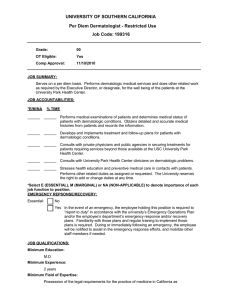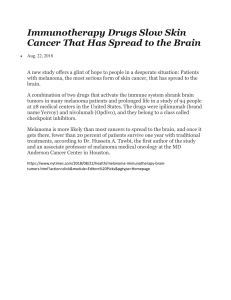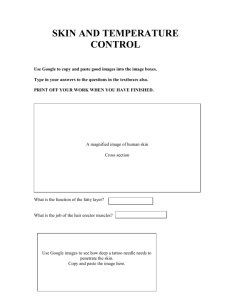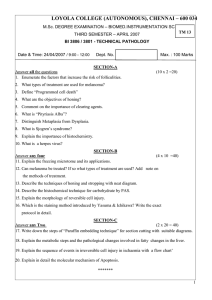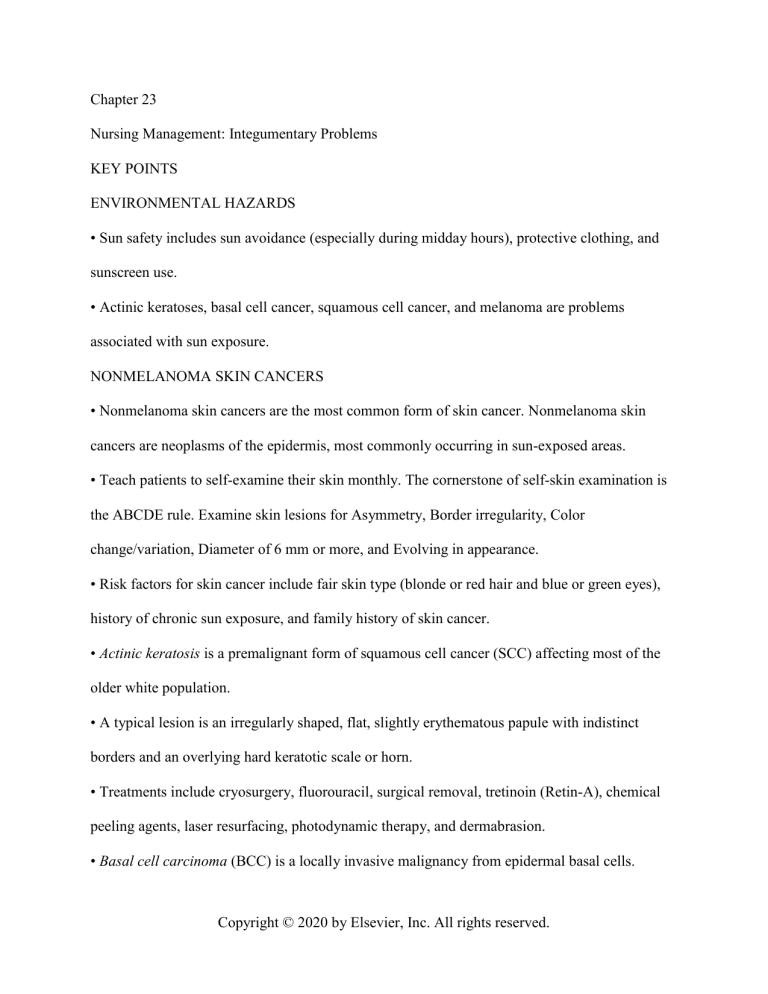
Chapter 23 Nursing Management: Integumentary Problems KEY POINTS ENVIRONMENTAL HAZARDS • Sun safety includes sun avoidance (especially during midday hours), protective clothing, and sunscreen use. • Actinic keratoses, basal cell cancer, squamous cell cancer, and melanoma are problems associated with sun exposure. NONMELANOMA SKIN CANCERS • Nonmelanoma skin cancers are the most common form of skin cancer. Nonmelanoma skin cancers are neoplasms of the epidermis, most commonly occurring in sun-exposed areas. • Teach patients to self-examine their skin monthly. The cornerstone of self-skin examination is the ABCDE rule. Examine skin lesions for Asymmetry, Border irregularity, Color change/variation, Diameter of 6 mm or more, and Evolving in appearance. • Risk factors for skin cancer include fair skin type (blonde or red hair and blue or green eyes), history of chronic sun exposure, and family history of skin cancer. • Actinic keratosis is a premalignant form of squamous cell cancer (SCC) affecting most of the older white population. • A typical lesion is an irregularly shaped, flat, slightly erythematous papule with indistinct borders and an overlying hard keratotic scale or horn. • Treatments include cryosurgery, fluorouracil, surgical removal, tretinoin (Retin-A), chemical peeling agents, laser resurfacing, photodynamic therapy, and dermabrasion. • Basal cell carcinoma (BCC) is a locally invasive malignancy from epidermal basal cells. Copyright © 2020 by Elsevier, Inc. All rights reserved. • Treatment includes surgical excision, electrodessication and curettage, cryosurgery, topical and systemic chemotherapy, photodynamic therapy, and radiation therapy. • Squamous cell carcinoma (SCC) is a cancer of keratinizing epidermal cells. • SCC can be very aggressive, has the potential to metastasize, and may lead to death if not treated early. With early detection and treatment, the cure rate is high. • Pipe, cigar, and cigarette smoking contribute to SCC on the mouth and lips. • Treatment includes surgical excision, electrodessication and curettage, excision, radiation therapy, photodynamic therapy, and intralesional injection of fluorouracil or methotrexate. MELANOMA • Melanoma tumors arise in melanocytes. It is the deadliest skin cancer, and its incidence is increasing faster than that of any other skin cancer. • Important prognostic factor of melanoma is tumor thickness at the time of diagnosis. Stage 0 is 100% curable, with stage IV being mostly palliative care. • The initial treatment for melanoma is surgery. A variety of therapies are available for metastatic melanoma. • Melanoma can metastasize to any organ. If it has spread to lymph nodes or nearby sites, immunotherapy, biologic therapy, and/or radiation therapy is often needed. Chemotherapy is limited to palliative pain control and the presence of brain metastases. • People with dysplastic nevus syndrome are at an increased risk for melanoma. SKIN INFECTIONS AND INFESTATIONS • Staphylococcus aureus and group A β-hemolytic streptococci are major types of bacteria responsible for primary and secondary skin infections. Copyright © 2020 by Elsevier, Inc. All rights reserved. • Herpes simplex, herpes zoster, and warts are the most common viral infections affecting the skin. • There are many possibilities for exposure to infestations, harboring insects or worms, and insect bites. ALLERGIC DERMATOLOGIC PROBLEMS • Allergies and hypersensitivity reactions may present as contact dermatitis and other lesions. • A careful history involving exposure to possible offending agents and patch testing are useful in determining the causative agent. The best treatment then becomes to avoid the cause. • Stevens Johnson syndrome (SJS) and toxic epidermal necrolysis (TEN) are rare, lifethreatening diseases that usually occur as a severe adverse drug reaction. • Patients with SJS/TEN have a blistering rash with sheet-like epidermal detachment accompanied by mucosal lesions in the eye, mouth, and genital areas. • Identifying and stopping the offending drug(s) is the most important action in caring for a patient with SJS/TEN. Immunotherapy may play a role in slowing disease progression and promoting skin repair. • Supportive care in an intensive care unit is essential. Interventions focus on airway management, preserving renal function, maintaining fluid and electrolyte balance, and pain control. BENIGN DERMATOLOGIC PROBLEMS • The most common benign dermatologic problems are acne, psoriasis, and seborrheic keratoses. • Psoriasis is a chronic, autoimmune dermatitis characterized by silvery, scaling plaques on the knees, elbows, scalp, hands, feet, and lower back. Copyright © 2020 by Elsevier, Inc. All rights reserved. • Psoriasis for most people is more emotionally disabling. The person may be self-conscious and withdraw from social contacts INTERPROFESSIONAL CARE: DERMATOLOGIC MANIFESTATIONS • After careful history, physical examination with visual inspection is necessary. Interprofessional Therapy • Ultraviolet light (UVL) of different wavelengths may be used to treat many dermatologic conditions, including psoriasis, cutaneous T-cell lymphoma, atopic dermatitis, vitiligo, and pruritus. Light sources available to treat skin problems include broadband UVB, narrowband UVB, and long-wave UV (UVA1). Radiation use for treatment of cutaneous malignancies varies greatly. Lasers are used for many dermatologic problems. • Antibiotics are used topically and systemically to treat dermatologic problems. Common overthe-counter topical antibiotics include bacitracin, minocycline, and polymyxin B. • Corticosteroids are particularly effective in treating a wide variety of dermatologic conditions. They are used topically, intralesionally, or systemically. High-potency corticosteroids may produce side effects when use is prolonged, including skin atrophy, rosacea eruptions, severe exacerbations of acne vulgaris, and dermatophyte infections. • Oral antihistamines are used to treat conditions that exhibit urticaria, angioedema, and pruritus. Antihistamines may have anticholinergic and/or sedative effects. Several different antihistamines may have to be tried to get an acceptable therapeutic effect. • Topical immune response modifiers such as pimecrolimus (Elidel) and tacrolimus (Protopic) are used in atopic dermatitis. Imiquimod (Aldara) stimulates the production of α-interferon and other cytokines to enhance cell-mediated immunity. It is used for external genital warts, actinic keratoses, and superficial basal cell cancer. Copyright © 2020 by Elsevier, Inc. All rights reserved. Diagnostic and Surgical Therapy • Diagnostic and surgical therapy techniques include skin scraping, electrodessication and electrocoagulation, curettage, punch biopsy, cryosurgery, and excision. • Tissue biopsy is the definitive test for diagnosing several skin lesions, particularly skin cancer. NURSING MANAGEMENT: DERMATOLOGIC PROBLEMS • Wet compresses are commonly used when skin is oozing from infection and/or inflammation, to relieve itching, to suppress inflammation, and to debride superficial wounds. • Baths are used to treat large body areas. They also have sedative and antipruritic effects. • Careful hand washing and safe disposal of soiled dressings are the best means of preventing spread of skin problems. • You are able to provide patient teaching about managing pruritus, applying topical medications, and proper skin care. • Factors affecting the outcome of long-term dermatologic problems include skin type, history of previous exacerbations, family history, complications, intolerance to therapy, environmental factors, and lack of adherence to the prescribed regimen. • It is important for you to assist with the emotional stress that can occur for persons who suffer from certain chronic skin problems or have undergone some surgical procedures. COSMETIC PROCEDURES • Cosmetic procedures include chemical peels, toxin injections, collagen fillers, laser surgery, breast enlargement and reduction, face-lift, eyelid lift, and liposuction. • Preoperative management includes informed consent and realistic expectations of what cosmetic surgery can accomplish. SKIN GRAFTS Copyright © 2020 by Elsevier, Inc. All rights reserved. • Skin grafts may be necessary to provide protection to underlying structures or to reconstruct areas for cosmetic or functional purposes. Ideally, wounds heal by primary intention. • Two traditional types of grafts are free grafts and skin flaps. Soft tissue expansion is a technique for resurfacing a defect, such as a burn scar; removing a disfiguring mark, such as a tattoo; or as a preliminary step in breast reconstruction. Engineered skin is helpful in certain situations. Copyright © 2020 by Elsevier, Inc. All rights reserved.
